Si vis pacem, para bellum - Die Pistole 08 Parabellum
It so happened that this gun was designed successively by two German engineers. In 1893, inventor Hugo Borchardt patented an automatic pistol that has an unusual barrel locking system based on the dead center principle of moving parts — the bolt, the connecting rod, and the bloodworm. The mechanical system was calculated mathematically, it worked exceptionally reliably, had very high accuracy of battle and impressive pulping. But, as gunsmiths know, only beautiful weapons shoot really well. Borchardt pistol design was disgusting. The weight balance was absent as such, and therefore the pistol, which possesses an ideal combat from the machine, did not fall at all when firing “from the hand”. It was a "ugly duckling", just a working model of a successful engineering idea.
Seven years later, in 1900, Borchardt’s theoretical concept was embodied in the real weapon system by another German designer, Georg Lüger, who completely changed the layout of the weapon. The pistol grip has adjusted the optimum angle of inclination and was orthopedically fitted to the average size of the palm of the arrow. In the tilted handle, the designer placed a return spring, which made it possible to significantly reduce the dimensions of the weapon and the mass of moving parts. We managed to lower the barrel along the axis as much as possible - and the angle of throwing at the shot decreased. The center of gravity shifted forward - and the weapon gained an impeccable weight balance. The gun has decreased in size, became easy and convenient. All this was achieved, while maintaining the reliability, accuracy and design capacity of the system. Georg Luger sought to create a portable, ultra-accurate and long-range fire weapon for athletes, foresters, hunters and travelers, suitable for survival in harsh conditions, able to suppress the enemy at the maximum distance of the pistol battle. But that was not all. The gun was created for commercial purposes - in order to buy it. He was obviously worked on by an unknown, but in his own way talented designer. The appearance of this weapon tuned the psyche to medieval Teutonic cruelty inherent in German aristocrats. The pistol conveyed to its owner an incomprehensible destructive psycho-energetics - he inspired a feeling of offensive aggressiveness to the one who held it in his hands. He received the commercial name corresponding to "Parabellum" (from the Latin dictum: "Si vis pacem, par bellum" - "If you want peace, prepare for war"). The ugly duckling turned into a hawk.
In the civilian commercial version, "Parabellum" was produced (and is still being produced) in 7,65 mm caliber. At one time, it favorably differed in weight, linear and ballistic characteristics from the rest of the automatic weapons.
The Kaiser military in a practical way reacted to the original design. They proposed to the inventor to increase the caliber of the system to 9 mm and recommended to adopt a gun to the Bundeswehr. The 9 mm cartridge with a “cut-off cone” type bullet (with a flat front platform, a crushing fabric of a living target when hit and causing shock) was specifically designed for the pistol. With the increase in the caliber "Parabellum" his amazing qualities increased so much that they make an impression in our time. In 1908, this weapon system was adopted by the German army under the code name Pistol 08 (die Pistole 08). The combat qualities of the new weapon were fully manifested in maneuverable partisan and semi-guerrilla large-scale conflicts that swept after the first world war around the globe. At that time, the best weapons of this class were not. Parabellum "began to be produced in China, Mexico, Iran, Turkey, Spain. He was in service in Switzerland, the Netherlands, Bulgaria and other countries under the name" Borchardt- Luger. "
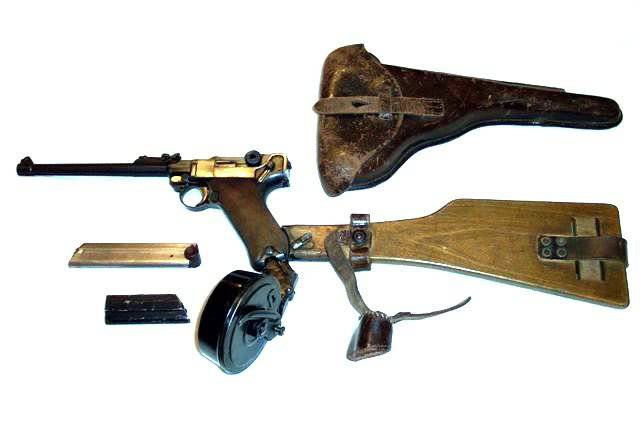
Automatic pistol based on the short course of the barrel back. The movable weapon system is a barrel with a receiver inside which are mounted the details of the locking mechanism and the percussion mechanism. The barrel with the front sight on the muzzle is connected to the barrel box using a threaded connection. The receiver has the shape of a plug. Inside the plug is placed and moves the bolt with the percussion mechanism and the ejector. The bolt is articulated with a connecting rod, and the latter with a bloodworm. The crank has a massive tooth that interacts with the beveled surface of the pistol frame when braking a moving system after a rollback. All the pivot-lever connection on the device is a crank mechanism, in which the slide is a bolt. Assembled with their details barrel and receiver can move in grooves in the longitudinal direction. The crank at the joints with the connecting rod has two rollers with a notched surface, made with it as one whole, which give the weapon an unusual look. Two deep cuts on these frames allow the crank to rest on the receiver so that the axis of the middle hinge becomes lower than the axes of the front and rear hinges.
In the forward position, the bolt locks, because the connecting rod and the bloodworm form an obtuse angle between them, with the top pointing down. When fired, the pressure of the powder gases is transmitted through the sleeve to the shutter. The receiver prevents the blunt angle between the hinge and the bloodworm from increasing, and under the effect of the recoil force, the entire above described system, in the locked state, moves back approximately 6 mm. Unlocking begins after the bullets are taken out of the barrel, when the moth rollers “get stuck” on the profile surfaces of the frame. The bloodworm begins to turn rollers up, the hinge-joint quickly passes through the dead position, after which the bloodworm gets a sharp increase in angular velocity, due to the curvilinearity of the profiled surfaces. The crank and the crank are folded, the shutter opens. When opening the shutter, the drummer cocks the connecting rod with the cocking tooth. The bloodworm is connected by means of a transmission lever to a return spring in the handle, which returns the moving system to its original position after the recoil energy has ceased. When moving forward, the bolt picks up the cartridge from the magazine and sends it to the barrel. When you press the trigger, the transfer lever mounted in the trigger cap acts on the release lever mounted on the receiver. The trigger lever is rotated on the axis, frees drummer, breaking the primer. A shot occurs and the reloading process starts over. When the barrel moves with the receiver back relative to the frame, the disconnector “hits” the side surface of the transmission lever and is installed inside the case. In this position, shooting is still impossible - you need to release the trigger.
In this case, the transfer lever moves to the side and releases the disconnector, which is under the action of the spring enters from the body of the trigger lever and becomes under the transfer lever. If you now press the trigger, the shot will be repeated. The trigger mechanism allows only single fire. The fuse is in the "Gesichert" position - the flag is lowered, the fuse bar blocks the trigger lever. Locking a cocked drummer is very reliable.
To load the "Parabellum" click on the latch store, then remove the store, equip it with ammunition. Equipped shop insert into the handle. The crank grabs hold of the rollers, moves up and down until it stops and is released. The weapon is ready to fire. An indicator of the presence of the cartridge in the chamber is the elevated position of the ejector. This opens the inscription "Geladen" -charged. When the last cartridge is used up, the bolt stops with a slide delay and the moving system stops in the movable position. In order to close the shutter, you must remove or slightly release the magazine and slightly move the bloodworm back. In the presence of cartridges in the store and open mobile system, the bloodworm is also fed back to the rollers - with the shutter coming off the slide delay.
Parabellum works very reliably. The supply of the cartridge from the store to the chamber excludes distortions and plugging of the cartridges - there is simply no place for the cartridge to “wriggle out” in the narrow space of the steel box fork. Sand and dust gun is not afraid - they are "blown" up after a shot from a small opening window of the receiver, followed by the residual pressure of the powder gases, which has been fired. Resource "Parabellum" is 25 thousands of shots. Interestingly, the older and more “flip-flopped” the mechanism, the softer the recoil is and, accordingly, less “throws” when fired. Due to the inevitably formed backlash between the parts of the moving system, the recoil impulse consistently acts on each of them and is not felt so sharply. With a preserved and well-groomed bore, the wear of the mechanism does not practically affect the accuracy of the fight.
Care, conservation, cleaning and lubrication "Parabellum" are made in the usual manner. It should be noted that the German gun steel, unlike the Russian, very much "likes to rust." Therefore, it has to be cleaned more thoroughly. The barrel of the Parabellum is not chromed. The Germans, like us, were not able to chromise their trunks in those days. The design of "Parabellum" is thought out to the smallest detail and is designed with true German accuracy. In essence, this is a compact firearm, where the work of parts and mechanisms is based on the strictest engineering design. Every detail, its mechanical and weight balance in the process of interaction with other parts and mechanisms, the resistance of the metal, are carefully calculated. From a mechanical point of view, the system is perfect - it makes the most of the energy of a powder charge to eject a bullet and minimally to reload a weapon. This is achieved thanks to the relatively small mass of the shutter and the specificity of its interaction with the rest of the moving parts. A weapon system designed only in this way could disperse a relatively heavy (7,9 gr.) Bullet up to the speed of 330 m / s. short - 85 millimeter barrel. The barrel itself is drilled on a light cone and processed very cleanly. The accuracy of the "Parabellum" battle is absolute and has not been surpassed on combat automatic pistols until now - the spread of bullets at a distance of 25 meters fits into the diameter of a five-kopeck coin. The main sample, the short-barreled Parabellum cobur, confidently “pulls” the target to the head at a distance of 100 meters. There were also pistols with a barrel length of 200 mm and aiming bar, like a rifle, notched at a distance of 300 meters, with a starting speed of an ordinary 390 bullet, m / sec. With the added butt-holster, such a pistol actually represented a lightweight automatic carbine. There was also a training version of the “Parabellum” caliber 5,6 mm and a special model with a silencer for silent shooting.
Pistols made before the war in various factories in Germany were of very high quality, with a large margin of safety with the highest precision of manufacturing, and impeccable cleanliness of machining of working surfaces of parts. "Parabellums", admitted in other countries from much worse materials, made not so carefully, also fired very well - the quality of shooting was determined by the engineering calculation incorporated in the design.
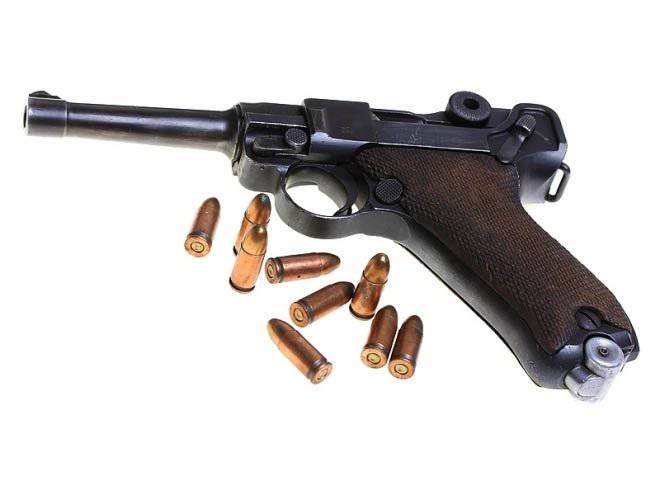
The 9x19 cartridges used for firing from the Parabellum (they are called “08 Parabellum”), according to their tactical and technical characteristics and design features, turned out to be almost the most practical for the operation of pistol automation. The sleeve of such ammunition slightly tapers on a cone from the middle of the body to the barrel (on 0,3 mm), which provides a lightweight extraction after the shot. With the advent of submachine guns, designed for this cartridge, the production of ammunition with a cut cone bullet stopped, and Germany switched to the production of Xnumx Parabellum cartridges with an ogival (ovoid) bullet, most suitable for the automatic operation of a submachine gun. These cartridges turned out to be so successful that since then and until now they have been used for firing from the overwhelming majority of systems of pistols and submachine guns. Before the war, the Germans produced a variant of such an ammunition with a powder charge increased by 08% - t referred to "carbine cartridge 20". The long-barreled "pistol" bullet cartridge was accelerated to such 08-470 m / sec rate.
The peculiarities of the mechanism provide the pistol with a higher rate of fire and an increased bullet effect on the target at long distances for pistol fire. It was designed for trained and trained shooters, but even a beginner is easy to shoot and easy to hit. Thanks to the orthopedic handles, the “Parabellum” sits in her hand like a glove. The barrel is low - almost at the level of the shooting hand. The locking system opens up, and therefore the weapon "gets off" when fired slightly. From the "Parabellum" you can conduct rapid rapid fire. Some inconvenience of loading is compensated by amazing accuracy of shooting - at a distance of direct visibility in the forest where he aimed, he got there. Moreover, I got it right away, from the first shot. From this pistol very well shoot, keeping the enemy at a respectful distance. The inclined handle allows you to effectively shoot offhand from the abdomen, without aiming at the silhouette, by ear in the dark. This weapon is ideal when shooting at running targets. The mechanical strength of the gun allows you to use it as a knuckle during hand-to-hand contact. Therefore, "Parabellum" was indispensable for front-line reconnaissance, saboteurs, special assignees, mercenaries and terrorists.
Essentially, the Parabellum was the weapon of a hunter-aristocrat, but it was only possible to hunt people. His appearance and physical sensations caused by him, aroused feelings of confident superiority and cruel inflexibility in accordance with the superman's fascist theory. These qualities of weapons rip and sports excitement of the German rangers in the fight against poorly armed partisans, and the bloodthirstiness of the SS officers, entertained by shooting at civilians.
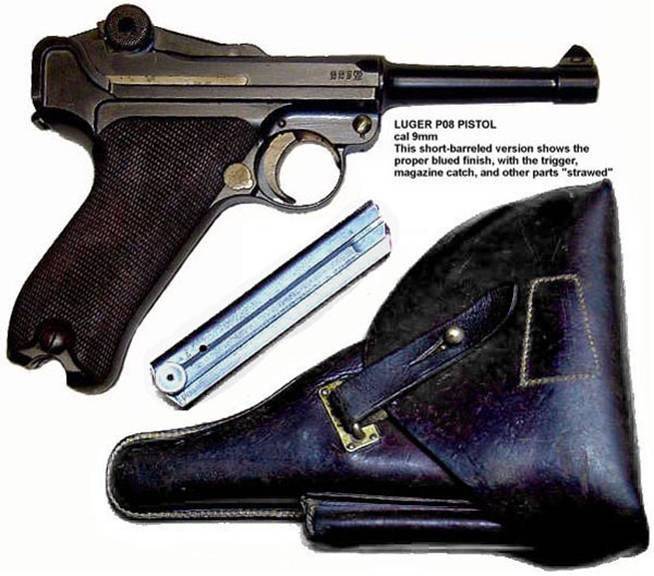
At the front, this gun didn’t show itself. Its accuracy and range were unclaimed against the background of the work of other automatic weapons, solving tactical tasks of increased density of fire. However, our officers did not miss the opportunity to remove the "Parabellum from a murdered German - as a personal holster weapon, it was incomparably better than a service TT."
Operatives, our and German, "Parabellum" did not like. He was not adapted to carry in his pocket, there was no self-platoon, so necessary for a sudden oncoming collision, to bring the weapon into the position of “battle” it was impossible to do with one hand. The fuse did not turn on uncomfortably and did not lock the moving parts - when the fuse was on, the shutter opened. With heavy pollution, in the cold, with a defective cartridge, thickening of grease, the moth did not lock the shutter completely - the disconnector reached the transfer lever, and in this position the locking system stopped, because the return spring was not strong enough. At long distances, this did not play a role - for sending the patron it was enough to slam on the crank with a hand from above, but at close distances from a detective battle "point-blank" any delay could be the last.
"Parabellum" was difficult to manufacture. The technology of its manufacture required a lot of milling operations. Even the shop was milled. Therefore, with the 1938 of the year, the Germans gave preference to the “Walter P-38”, which was more practical and adapted to carrying out a sudden fire at close distances, although the “Parabellum” continued to be produced until the last days of the war. I have seen such an 1945 ersatz pistol of the year with plastic handle cheeks and a shop stamped from roofing iron.
After World War II, the release of Parabellum pistols was discontinued. It was not modernized - no one managed to create a more perfect automation system. Attempts by other designers to design a weapon operating on the same principle were unsuccessful. The concept of the relationship between the design of the Parabellum and the layout of its mechanism remained unsolved. The phenomenon of the impact of the external design of the gun on the psyche of the arrow has not yet been studied. In many countries, the military version of the Parabellum has been declared a weapon of targeted destruction and is prohibited for use. Despite the fact that over the past 50 years, a huge number of these pistols sent to the smelter, "Parabellum" has reached our days. Interest in it does not disappear: "Parabellum" - the subject of desire of weapons collectors and salable goods in the shops of military antiques. There is such a weapon both in museums and in ... arsenals of special forces - for particularly precise work.
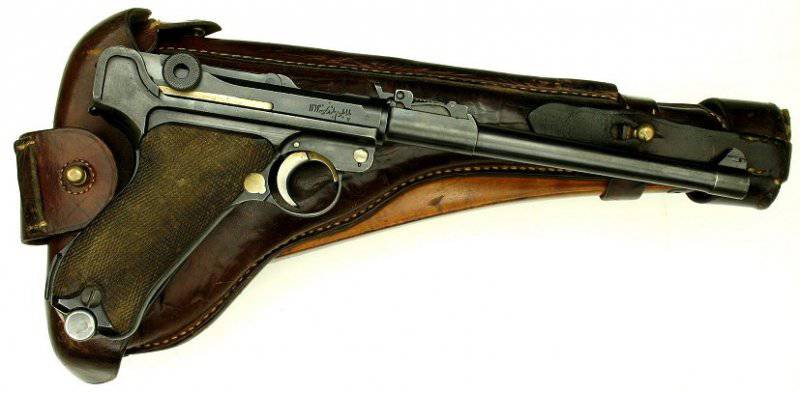
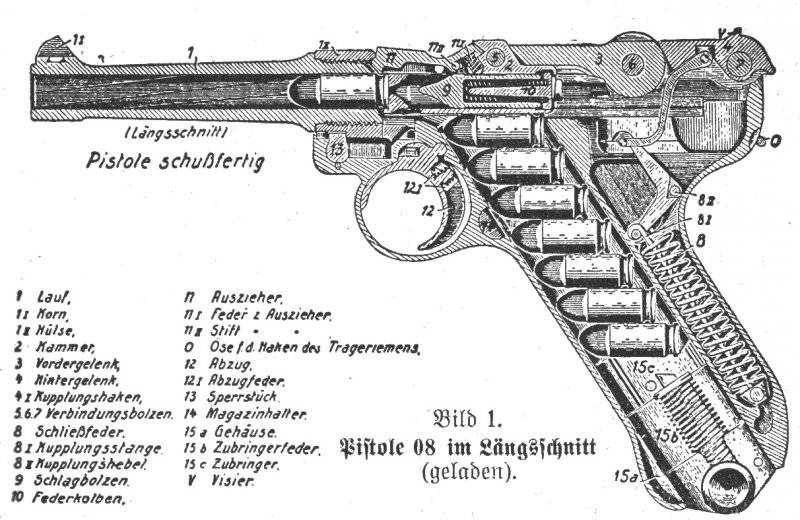
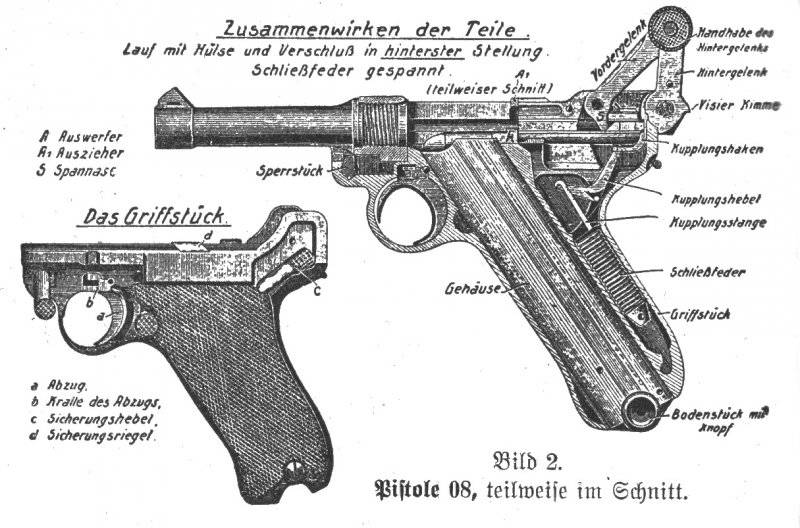
Information